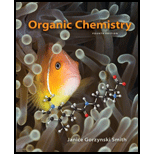
(a)
Interpretation:
To determine the steps are in the reaction mechanism?
Concept introduction:
An energy diagram is a schematic representation of the energy changes that take place as reactants that are converted into products. An energy diagram indicates how readily a reaction can proceeds, how many steps are involved in the reaction, and how the energies of the reactants, products, and intermediates compare.
(b)
Interpretation:
To label the Ea and ∆Ho for each step, and the ∆Ho overall for the reaction
Concept introduction:
An energy diagram is a schematic representation of the energy changes that take place as reactants that are converted into products. An energy diagram indicates how readily a reaction can proceeds, how many steps are involved in the reaction, and how the energies of the reactants, products, and intermediates compare. The energy difference between the transition state and the starting material is called the energy of activation, symbolized by Ea. The larger the Ea, the greater the amount of energy that is needed to break bonds, and the slower the reaction rate.
The energy difference between the reactants and products is ∆Ho. Because the products are at lower energy than the reactants, this reaction is exothermic and energy is released.
Thus
Ea determines the height of the energy barrier.
∆Ho determines the relative position of the reactants and products
(c)
Interpretation:
To draw the structure of the transition state for each step and indicate its location on the energy diagram
Concept introduction:
An energy diagram is a schematic representation of the energy changes that take place as reactants that are converted into products. An energy diagram indicates how readily a reaction can proceeds, how many steps are involved in the reaction, and how the energies of the reactants, products, and intermediates compare. The energy difference between the transition state and the starting material is called the energy of activation, symbolized by Ea. The larger the Ea, the greater the amount of energy that is needed to break bonds, and the slower the reaction rate.
The energy difference between the reactants and products is ∆Ho. Because the products are at lower energy than the reactants, this reaction is exothermic and energy is released.
Thus
Ea determines the height of the energy barrier.
∆Ho determines the relative position of the reactants and products
(c)
Interpretation:
Predict the rate-determining step and explain it.
Concept introduction:
An energy diagram is a schematic representation of the energy changes that take place as reactants that are converted into products. An energy diagram indicates how readily a reaction can proceeds, how many steps are involved in the reaction, and how the energies of the reactants, products, and intermediates compare. The energy difference between the transition state and the starting material is called the energy of activation, symbolized by Ea. The larger the Ea, the greater the amount of energy that is needed to break bonds, and the slower the reaction rate.
The energy difference between the reactants and products is ∆Ho. Because the products are at lower energy than the reactants, this reaction is exothermic and energy is released.
Thus
Ea determines the height of the energy barrier.
∆Ho determines the relative position of the reactants and products
In a multistep mechanism, the step with the highest energy transition state is called the rate-determining step.
Want to see the full answer?
Check out a sample textbook solution
Chapter 6 Solutions
Organic Chemistry-Package(Custom)
- Explain how, based on physical gas adsorption isotherms, we can determine whether multi-walled C nanotubes are open at their ends. Explain this.arrow_forwardcan somone answer pleasearrow_forwardConstruct a molecular orbital energy-level diagram for BeH2. Sketch the MO pictures (schematic representation) for the HOMO and LUMO of BeH2 [Orbital Potential Energies, H (1s): -13.6 eV; Be (2s): -9.3 eV, Be (2p): -6.0 eV]arrow_forward
- Indicate the isomers of the A(H2O)6Cl3 complex. State the type of isomerism they exhibit and explain it briefly.arrow_forwardState the formula of the compound potassium μ-dihydroxydicobaltate (III) tetraoxalate.arrow_forwardConsider the reaction of the cyclopentanone derivative shown below. i) NaOCH2CH3 CH3CH2OH, 25°C ii) CH3!arrow_forward
- What constitutes a 'reference material', and why does its utilization play a critical role in the chemical analysis of food products? Provide examples.arrow_forwardExplain what calibration is and why it is essential in relation to food analysis. Provide examples.arrow_forwardThe cobalt mu-hydroxide complex cobaltate(III) of potassium is a dinuclear complex. Correct?arrow_forward
- The cobalt mi-hydroxide complex cobaltate(III) of potassium is a dinuclear complex. Correct?arrow_forward3. Arrange the different acids in Exercise B # 2 from the strongest (1) to the weakest acid (10). 1. 2. (strongest) 3. 4. 5. 6. 7. 8. 9. 10 10. (weakest)arrow_forwardName Section Score Date EXERCISE B pH, pOH, pка, AND PKD CALCULATIONS 1. Complete the following table. Solution [H+] [OH-] PH РОН Nature of Solution A 2 x 10-8 M B 1 x 10-7 M C D 12.3 6.8 2. The following table contains the names, formulas, ka or pka for some common acids. Fill in the blanks in the table. (17 Points) Acid Name Formula Dissociation reaction Ka pka Phosphoric acid H₂PO₁ H3PO4 H++ H₂PO 7.08 x 10-3 Dihydrogen H₂PO H₂PO H+ HPO 6.31 x 10-6 phosphate Hydrogen HPO₁ 12.4 phosphate Carbonic acid H2CO3 Hydrogen HCO 6.35 10.3 carbonate or bicarbonate Acetic acid CH,COOH 4.76 Lactic acid CH₂CHOH- COOH 1.38 x 10 Ammonium NH 5.63 x 10-10 Phenol CH₂OH 1 x 10-10 Protonated form CH3NH3* 3.16 x 10-11 of methylaminearrow_forward
 Organic Chemistry: A Guided InquiryChemistryISBN:9780618974122Author:Andrei StraumanisPublisher:Cengage Learning
Organic Chemistry: A Guided InquiryChemistryISBN:9780618974122Author:Andrei StraumanisPublisher:Cengage Learning Organic ChemistryChemistryISBN:9781305580350Author:William H. Brown, Brent L. Iverson, Eric Anslyn, Christopher S. FootePublisher:Cengage Learning
Organic ChemistryChemistryISBN:9781305580350Author:William H. Brown, Brent L. Iverson, Eric Anslyn, Christopher S. FootePublisher:Cengage Learning Living By Chemistry: First Edition TextbookChemistryISBN:9781559539418Author:Angelica StacyPublisher:MAC HIGHER
Living By Chemistry: First Edition TextbookChemistryISBN:9781559539418Author:Angelica StacyPublisher:MAC HIGHER Physical ChemistryChemistryISBN:9781133958437Author:Ball, David W. (david Warren), BAER, TomasPublisher:Wadsworth Cengage Learning,
Physical ChemistryChemistryISBN:9781133958437Author:Ball, David W. (david Warren), BAER, TomasPublisher:Wadsworth Cengage Learning,



